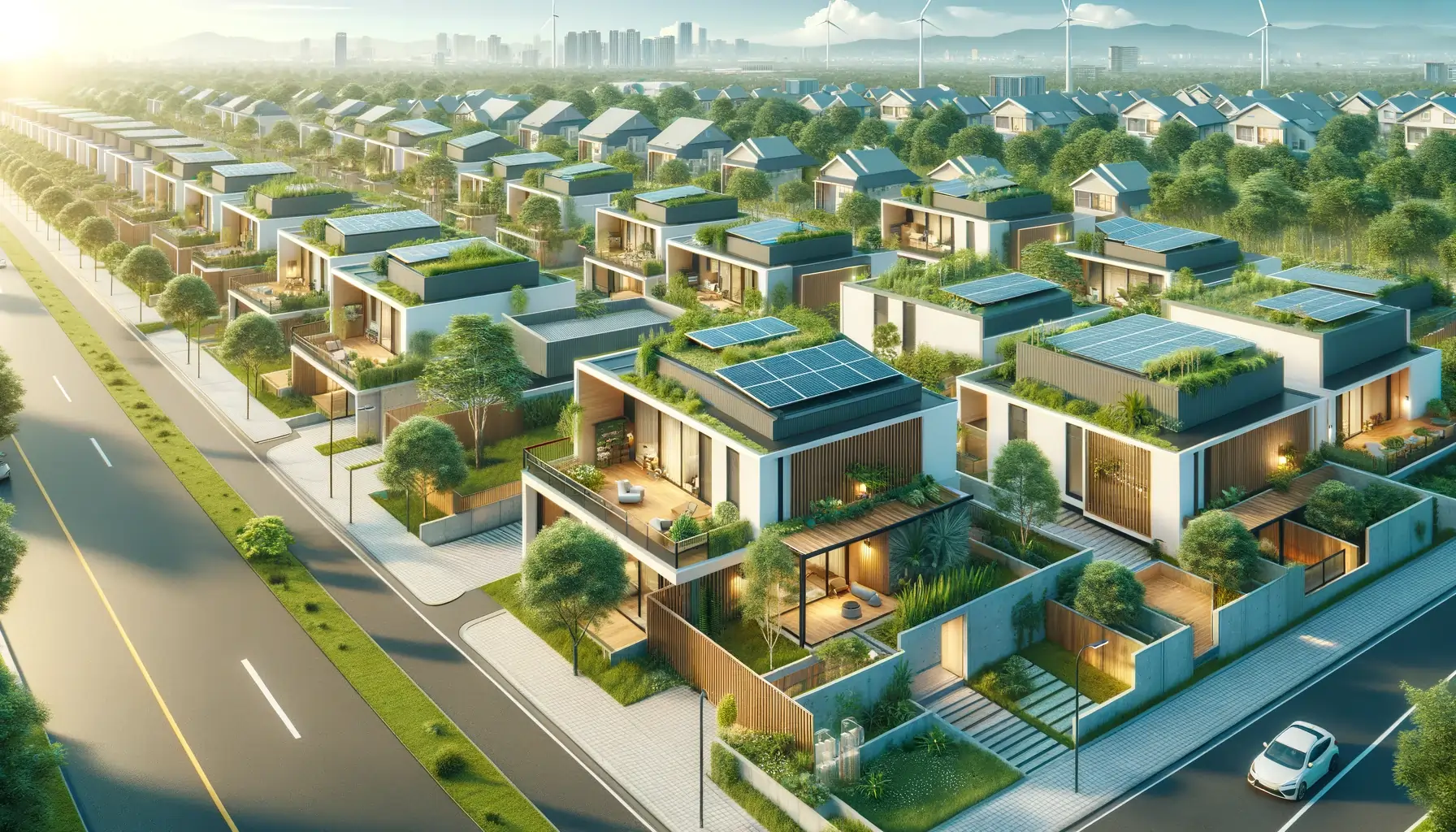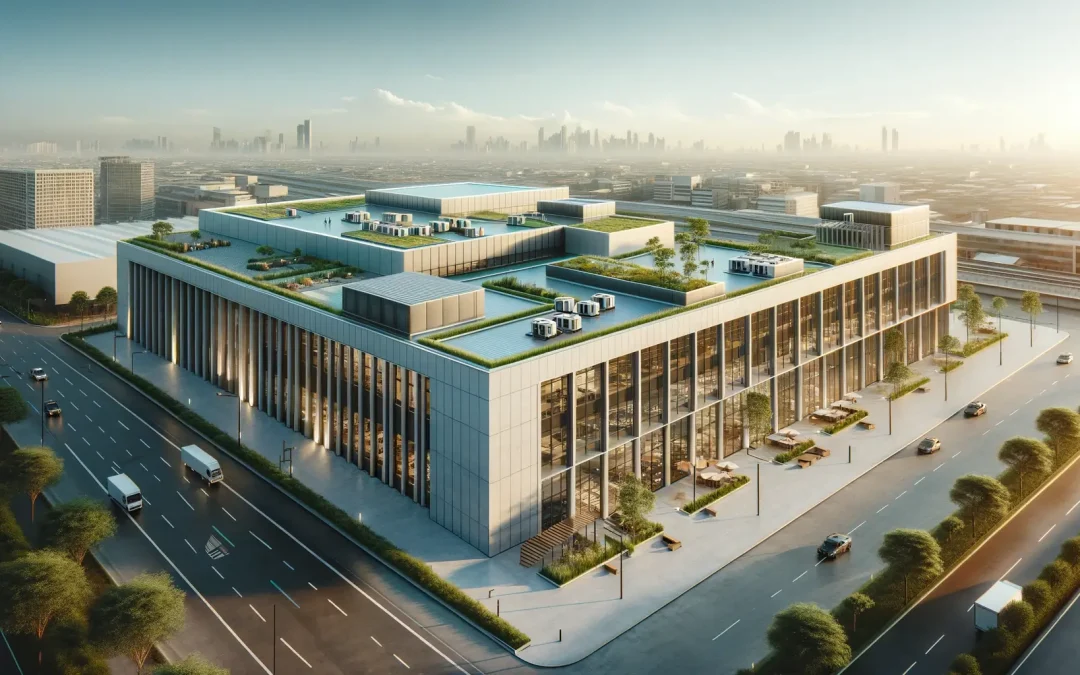Flat roofs are commonly found in a variety of types of structures. However, the decision to choose a flat roof for a particular building requires consideration. They are different from the more aesthetic pitched roofs that we often see in single-family houses and smaller buildings. Nevertheless, flat roofs offer a number of benefits in certain contexts and can be the optimal solution for new buildings. When it comes to the decision to use or replace a flat roof, there are many types of roofing materials available that can meet the expectations of both property owners and administrators.
Spis treści:
Why flat roofs?
Flat roofs offer a number of benefits that make them an ideal choice for certain types of facilities. They are particularly suitable for larger structures and those that require frequent use of the roof, as they are usually lighter, and their installation is often less expensive and allows easy access.
An important aspect to keep in mind is that flat roofs are not literally flat. They are designed with a slight slope, which is designed to facilitate water drainage. Nevertheless, due to the smaller angle of inclination compared to steep roofs, drainage on flat roofs is slower, which requires regular maintenance. It is imperative to ensure that the roof surface remains waterproof and airtight to prevent leaks and potential damage to the structure below. Regular, annual inspections are crucial to identify and repair areas damaged by UV or moisture, ensuring long-term protection and safety for the building.
Commercial Building Roofs
Flat roofs are often chosen for commercial buildings where comfort, accessibility, safety and cost are a priority. This preference is due to the fact that the materials used for flat roofs are generally lighter and less expensive than those used for more aesthetically advanced pitched roofs. For large structures, flat roof systems prove to be particularly practical, not only reducing the structural load on the building, but also reducing the overall costs of the project.
Industrial, warehouse, commercial, hotel and other commercial buildings are often equipped with numerous HVAC systems and other installations located on roofs, which require quick and trouble-free access through roof hatches for maintenance crews both during the day and at night. Flat roofs make it much easier to access these devices, enabling efficient maintenance and repairs. In addition, the location of air conditioners, recuperation systems and other systems on the roof saves valuable space inside the building. In addition, roofs of this type are perfect for installing skylights in the roof and continuous strips, whose task is to illuminate rooms using natural sunlight.
What’s more, for roofers and other professionals working at heights, flat roofs minimize the risk of slipping accidents on steep surfaces, increasing work safety.
Application of flat roofs in residential construction
Flat roofs are also widely used in high-rise residential and office buildings in urban environments where the availability of various services is crucial. From the perspective of design and use of space, the roofs of urban buildings are valued as attractive outdoor spaces, offering residents and visitors access to sunlight and fresh air. Tall buildings such as apartment buildings, apartments, and hotels often adapt their roofs to create gardens, install effective lighting, dining areas, and even sports arenas or swimming pools. With flat roofs, the design possibilities are limited only by creativity.

Flat roofs are also a popular choice for single-family homes and other smaller buildings, where factors such as climate, aesthetics, design, and budget make them a suitable option. They are especially practical in regions with dry climates, where rainfall is rare and snow is not a problem for the roof. Flat roofs can contribute to sustainable and energy-efficient housing solutions, offering space for the installation of solar panels or the creation of green roofs covered with living vegetation.
The best materials used in the construction of flat roofs
Flat roofs, due to their versatility and practicality, can be made from a variety of materials, each offering unique advantages and specifications. Below are the four most common materials used in the construction of flat roofs.
PVC membrane
PVC membrane is a modern solution in the field of waterproofing, used in both commercial and residential construction, providing effective protection against water. It is a flexible, durable membrane made of a non-woven polyester fabric, known as a “scrim”, which provides a seal and is flame retardant. Scrim is laminated with thermoplastic PVC, which is resistant to UV radiation, which significantly increases the durability and resistance of the membrane to adverse weather conditions.
Thanks to their lightness, PVC roofs do not overload the building structure, which allows them to be installed directly on existing roofing. This is particularly beneficial because it reduces the amount of waste sent to landfills.
PVC roofing is characterized by high durability and reliability. They are resistant to high temperatures, dirt and strong winds, which makes them an excellent choice for a variety of construction projects, guaranteeing long-term protection against external elements.
Built-in roof (BUR)
A built-in roof (BUR) is a traditional roofing method that uses layers of hot tar and gravel. The construction process involves layering hot tar between at least three waterproof sheets of materials, ending with a layer of smooth river stones or gravel.
BUR is often chosen for commercial buildings, mainly because of its price attractiveness. It is a cost-effective solution that offers robust protection for large roof areas. In addition, one of the biggest advantages of a BUR roof is its fire resistance. Gravel, being a natural fire-resistant material, increases the safety of the facility in the event of a fire.
Despite these advantages, BUR roofs also have their disadvantages. One of them is the specific, unpleasant smell of asphalt, which can be considered undesirable. Installation of this type of roof can be messy and complicated, and its disassembly – difficult and time-consuming. In addition, the use of tar and gravel makes BUR roofs heavy, which can put an additional strain on the building structure, requiring a prior assessment of the structure’s load-bearing capacity.
Rubber membrane
The rubber membrane, also known as EPDM (ethylene-propylene-diene-monomer), is a popular option for flat roofs, valued for its durability and lightness. Although EPDM is commonly used for these advantages, it is worth noting that it is typically less puncture-resistant than alternative roofing membranes such as PVC. Despite this difference, both materials – EPDM and PVC – offer similar recyclability, which is beneficial from an ecological point of view.
However, the use of a rubber membrane may have some limitations, especially in warmer climates. Due to the naturally dark color of the EPDM membrane, roofs made of this material can be more susceptible to absorbing heat, which can lead to higher temperatures inside the building. This phenomenon can affect the thermal comfort of rooms under the roof and the costs of air conditioning, especially in regions with high temperature and sunlight.
TPO roof
TPO, or thermoplastic polyolefin, is an innovative roofing solution that combines the advantages of two different types of rubber. Its white color is a significant advantage in terms of energy saving, as it effectively reflects the sun’s rays. This property contributes to a reduction in the temperature on the roof surface, which in turn can significantly reduce the need for cooling the building’s interiors, resulting in savings in energy bills.
The installation of the TPO roof is extremely simple – it can be both fully glued and mechanically attached to the roof deck. In addition, TPO stands out for its extraordinary flexibility, which makes it extremely versatile compared to other roofing materials. This flexibility, combined with durability, makes TPO an attractive choice for many construction projects, offering long-term protection and energy efficiency.
Metal roofing
Low slope metal roofing offers a unique alternative to traditional materials used on flat roofs, standing out for its beauty, quality and design. Metal, being a durable and decorative material, offers longevity and minimal maintenance requirements, making it an attractive choice for many owners.
The aesthetics of roofs made of copper, zinc or aluminum is unquestionable, and each of these materials shows high resistance to weather conditions. Their ability to reflect the sun’s rays not only contributes to a cooler indoor climate, but also contributes to energy efficiency. In addition, metal roofs are fully recyclable, which emphasizes their ecological nature.
The popularity of metal roofs is growing among both homeowners and companies who want to increase the aesthetics and value of their property. Metal offers unparalleled formability into a variety of shapes, allowing you to create unique, custom roof structures. Such solutions not only emphasize the individual character of the building, but also add elegance and sophistication through elements such as roof overhangs, gutters and other decorative accessories, allowing it to stand out from other buildings.
Popular roof shapes in architecture
| Roof type | Description | Slope range (degrees) | Use |
|---|---|---|---|
| Flat | Minimum slope for rainwater drainage | 0-5 | Commercial buildings, modern residential homes |
| Gable | Two sloping slopes meeting at the top | 20-45 | Single-family houses, garages, outbuildings |
| Hipped | Four slopes sloping towards the center of the building | 25-45 | Traditional style houses, gazebos |
| Mansard | Combination of flat and gable roof | Bottom: 20-30, Top: 70-90 | Renovation of monuments, adding additional living space in the attic |
| Tent | Four triangular faces forming the top | 45-60 | Towers, decorative elements in historical architecture |
| Envelope | Three or more slopes inclined to a single point | 30-50 | Buildings with unusual shapes, houses with large terraces |
| Broken | Changing the slope angle in the middle of the height | Lower part: 30-45, Upper part: 45-60 | Houses with a usable attic, increasing the space under the roof without changing the total height |
| Walmdach (pediment roof) | Combination of a gable roof with two trapezoidal side walls | 22-27 | Single-family houses, residential buildings with the pursuit of symmetry and structural stability |
Summary
In conclusion, the article focuses on the diversity of flat roofs, presenting their key advantages, applications and suitable building materials. The discussion covers both practical and aesthetic aspects, emphasizing the importance of choosing the right type of roof in the context of specific design and climate requirements. It provides valuable tips that can help you make an informed decision about the most suitable roofing solution.
Autor: Tomasz Matuszek; Dział Marketingu - Firma Gulajski

